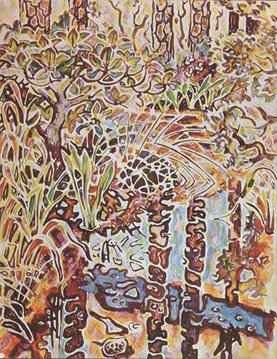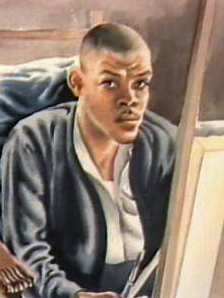Related Research Articles

Charles Henry Alston was an American painter, sculptor, illustrator, muralist and teacher who lived and worked in the New York City neighborhood of Harlem. Alston was active in the Harlem Renaissance; Alston was the first African-American supervisor for the Works Progress Administration's Federal Art Project. Alston designed and painted murals at the Harlem Hospital and the Golden State Mutual Life Insurance Building. In 1990, Alston's bust of Martin Luther King Jr. became the first image of an African American displayed at the White House.

Rockwell Kent was an American painter, printmaker, illustrator, writer, sailor, adventurer and voyager.

Thomas Hart Benton was an American painter, muralist, and printmaker. Along with Grant Wood and John Steuart Curry, he was at the forefront of the Regionalist art movement. The fluid, sculpted figures in his paintings showed everyday people in scenes of life in the United States.

Aaron Douglas was an American painter, illustrator, and visual arts educator. He was a major figure in the Harlem Renaissance. He developed his art career painting murals and creating illustrations that addressed social issues around race and segregation in the United States by utilizing African-centric imagery. Douglas set the stage for young, African-American artists to enter the public-arts realm through his involvement with the Harlem Artists Guild. In 1944, he concluded his art career by founding the Art Department at Fisk University in Nashville, Tennessee. He taught visual art classes at Fisk University until his retirement in 1966. Douglas is known as a prominent leader in modern African-American art whose work influenced artists for years to come.

Walter Inglis Anderson was an American painter and writer.

Elizabeth Catlett, born as Alice Elizabeth Catlett, also known as Elizabeth Catlett Mora was an American and Mexican sculptor and graphic artist best known for her depictions of the Black-American experience in the 20th century, which often focused on the female experience. She was born and raised in Washington, D.C., to parents working in education, and was the grandchild of formerly enslaved people. It was difficult for a black woman at this time to pursue a career as a working artist. Catlett devoted much of her career to teaching. However, a fellowship awarded to her in 1946 allowed her to travel to Mexico City, where she settled and worked with the Taller de Gráfica Popular for twenty years and became head of the sculpture department for the Escuela Nacional de Artes Plásticas. In the 1950s, her main means of artistic expression shifted from print to sculpture, though she never gave up the former.

Hale Aspacio Woodruff was an American artist known for his murals, paintings, and prints.

Charles Wilbert White, Jr. was an American artist known for his chronicling of African American related subjects in paintings, drawings, lithographs, and murals. White's lifelong commitment—to chronicling the triumphs and struggles of his community in representational form—cemented him as one of the most well-known artists in African American art history. Following his death in 1979, White's work has been included in the permanent collections of the Art Institute of Chicago, Los Angeles County Museum of Art, The Metropolitan Museum of Art, the Whitney Museum of American Art, the National Gallery of Art, The Newark Museum, and the Santa Barbara Museum of Art. White's best known work is The Contribution of the Negro to American Democracy, a mural at Hampton University. In 2018, the centenary year of his birth, the first major retrospective exhibition of his work was organized by the Art Institute of Chicago and the Museum of Modern Art.

Eldzier Cortor was an African-American artist and printmaker. His work typically features elongated nude figures in intimate settings, influenced by both traditional African art and European surrealism. Cortor is known for his style of realism that makes accurate depictions of poor, Black living conditions look fantastic as he distorts perspective.

The South Side Community Art Center is a community art center in Chicago that opened in 1940 with support from the Works Progress Administration's Federal Art Project in Illinois. Opened in Bronzeville in an 1893 mansion, it became the first black art museum in the United States and has been an important center for the development Chicago's African American artists. Of more than 100 community art centers established by the WPA, this is the only one that remains open.

Norman Wilfred Lewis was an American painter, scholar, and teacher. Lewis, who was African-American and of Bermudian descent, was associated with abstract expressionism, and used representational strategies to focus on black urban life and his community's struggles.

Queena Stovall was an American folk artist. Sometimes called "The Grandma Moses of Virginia," she is famous for depicting everyday events in the lives of both white and black families in rural settings.
Francisco Mora was a Mexican artist of the "Mexican School" of mural painters.

The Chicago Black Renaissance was a creative movement that blossomed out of the Chicago Black Belt on the city's South Side and spanned the 1930s and 1940s before a transformation in art and culture took place in the mid-1950s through the turn of the century. The movement included such famous African-American writers as Richard Wright, Margaret Walker, Gwendolyn Brooks, Arna Bontemps, and Lorraine Hansberry, as well as musicians Thomas A. Dorsey, Louis Armstrong, Earl Hines and Mahalia Jackson and artists William Edouard Scott, Elizabeth Catlett, Katherine Dunham, Charles Wilbert White, Margaret Burroughs, Charles C. Dawson, Archibald John Motley, Jr., Walter Sanford, and Eldzier Cortor. During the Great Migration, which brought tens of thousands of African-Americans to Chicago's South Side, African-American writers, artists, and community leaders began promoting racial pride and a new black consciousness, similar to that of the Harlem Renaissance. Unlike the Harlem Renaissance, the Chicago Black Renaissance did not receive the same amount of publicity on a national scale. Among the reasons for this are that the Chicago group participants presented no singularly prominent "face", wealthy patrons were less involved, and New York City—home of Harlem—was the higher profile national publishing center.

Zapata (1932) is a lithograph by the Mexican artist Diego Rivera (1886–1957) that depicts the Mexican revolutionary Emiliano Zapata (1879–1919) as he holds the reins of a horse among a group of campesinos (peasants). The lithographic edition was created and printed twelve years after Zapata's assassination. Zapata is based on Agrarian Leader Zapata (1931), one of eight "portable" frescoes produced explicitly for Rivera's solo exhibition at the Museum of Modern Art (MoMA) in 1931, which was adapted from his previous Revolt panel from a fresco titled The History of Cuernavaca and Morelos (1929–30) painted in the Palace of Cortés, Cuernavaca. There were 100 original prints of the lithograph, many of which are in the collections of various art museums.

Suzanne Jackson is an American visual artist, gallery owner, poet, dancer, educator, and set designer; with a career spanning five decades. Her work has been exhibited in museums and galleries around the world. Since the late 1960s, Jackson has dedicated her life to studio art with additional participation in theatre, teaching, arts administration, community life, and social activism. Jackson's oeuvre includes poetry, dance, theater, costume design, paintings, prints, and drawings.
Vincent DaCosta Smith was an American artist, painter, printmaker and teacher. He was known for his depictions of black life.
William Thacker McBride Jr. was an African-American artist, designer and collector. McBride began his career in the 1930s in the circles of black art collectives and artistic opportunities afforded by the Works Progress Administration. He would ultimately leave his mark in Chicago as a driving force behind the South Side Community Art Center. McBride distinguished himself as a teacher, as a cultural and political activist, and as a collector of African art and artwork by black artists of his generation.

John N. Robinson was an African-American artist who lived and worked in Washington, D.C. He made realist paintings showing the people and places of his family home, his neighborhood, and the city in which he lived. Called "quiet and conscientious" and praised for works of "sincerity and humility," he was particularly noted for portraits that showed his sitters in a way that successfully revealed their individual character. A critic for Washington Post characterized his paintings as "hymns to the ordinary" and said they were "warmed by gratitude and gentleness."
Ed McGowin is an American painter and sculptor based in New York City. Throughout his career, McGowin has produced works in a wide variety of media that have been installed and exhibited in galleries, museums and public spaces. He has taught at institutions such as the Corcoran School of the Arts and Design, the University of Southern Mississippi, and the State University of New York system. The first major publication of his work, Name Change: One Artist – Twelve Personas – Thirty Five Years, was published by the Mobile Museum of Art in 2006 and distributed by the University Press of Mississippi.
References
- 1 2 3 4 5 6 7 8 9 10 11 12 13 14 15 Fax, Elton C. (1971). Seventeen Black Artists. New York: Dodd, Mead & Company. pp. 48–62.
- 1 2 3 4 5 Crouther, Betty (January 1, 2001). "A voice and vision from the deep south: Lawrence A. jones of mississippi". The International Review of African American Art. 17: 10. ProQuest 1302711876.(subscription required)
- 1 2 "Jackson (miss.) art teacher enjoys his long, fruitful career". Tri - State Defender. April 22, 1972. ProQuest 369509306.(subscription required)
- ↑ Williams, Reba; Dave, Williams (1993). Alone in a Crowd : Prints of the 1930s-40s by African-American Artists : From the Collection of Reba and Dave Williams. Topeka, KS: Washburn Press. p. 40.
- 1 2 3 4 5 6 Swanson, Lealan N. (2007). "Lawrence Arthur Jones (1910-1996): black artist and Southern educator". Southeastern College Art Conference Review. 15 (2): 169.
- ↑ "In the Alley". www.metmuseum.org.
- ↑ "Seated Man with Suitcase". www.metmuseum.org.
- ↑ "The Ghetto, Maxwell Street". www.metmuseum.org.
- ↑ "Steel Workers Resting". www.metmuseum.org.
- ↑ "Hull House, Chicago". www.metmuseum.org.
- ↑ "Poland '46". www.nga.gov. 1946.